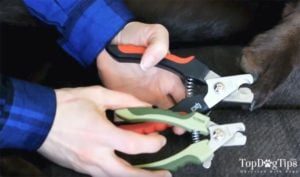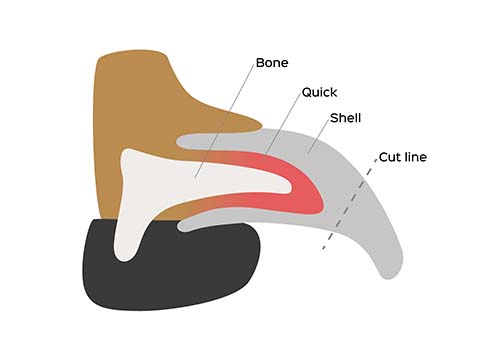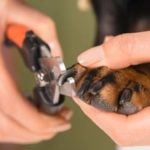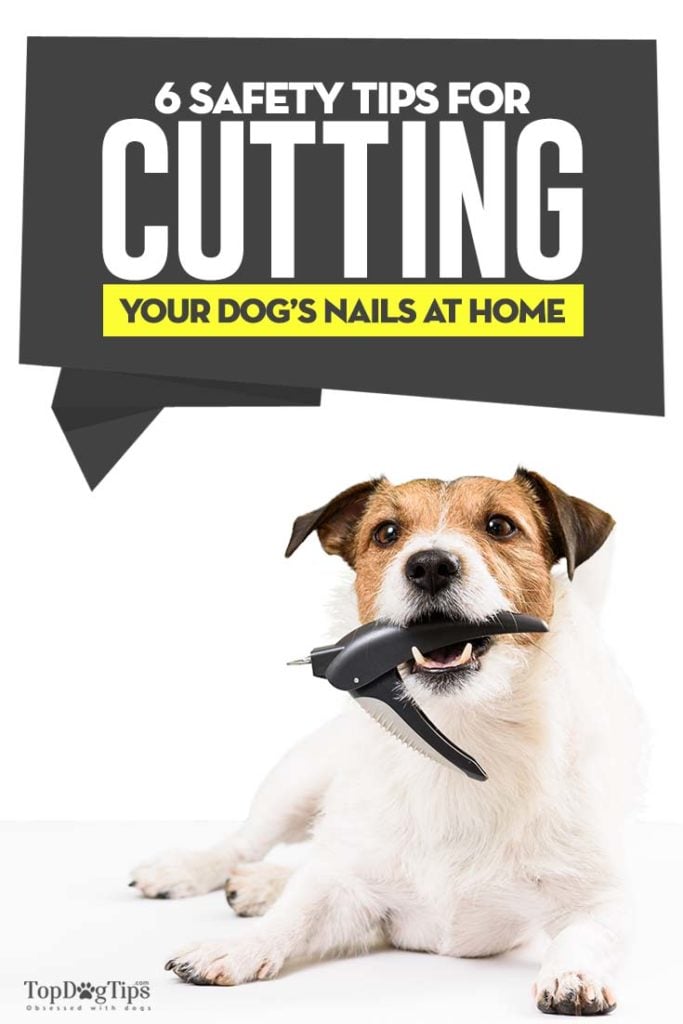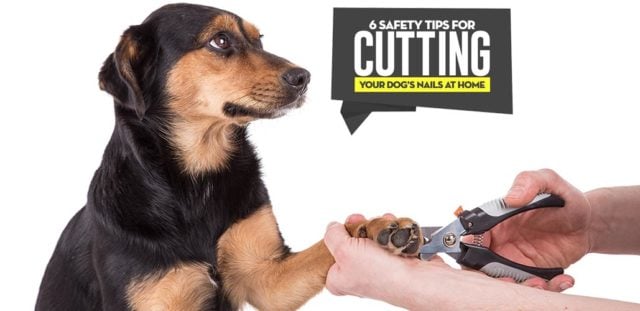
Table of Contents
It's time to cut your dog's nails, but you're not sure how to do it. Your dog is fidgety; you've never done this before, and you're afraid of cutting your dog's nails.
These are fair concerns, so here's everything you need to know about cutting dogs' nails at home safely and without too much hassle.
Expect the first few times to be difficult, but you (and your dog) will get better with practice.
If you feel nervous about cutting a dog's nails, know that the process is quick and easy once you've planned for every step of the way understand how to calm down your dog, and have him enjoy the grooming process.
There's a right way and a wrong way to do this. It's important to consider the safety of cutting dog nails at home because you're working with a sharp tool, and many dogs don't like getting their nails trimmed.
The goal is to prepare what to expect from the dog and keep your pet still, comfortable, stress-free, and stable to prevent injury.

6 Safety Tips for Cutting Dog's Nails
1. Pick the Right Dog Nail Cutting Tools
There are several tools for trimming a dog’s nails. Which works best for you depends on your budget, your dog’s behavior, breed, and personality, and your experience and ability at cutting a dog's nails.
The best dog nail-cutting and trimming tools include the following.
Dog nail clippers 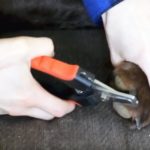
Make sure you get pet nail clippers that are designed for dogs specifically. You can’t cut your canine's nails with clippers for people or even those for cats. All dog nail clippers come in different sizes, styles, and prices and are great for dogs who don’t like the sounds of electric devices.
Nail file pads
This item sits on the floor, and dogs can use it themselves. It works like a scratching post for cats.
They take more time at first, as you need to train your pet to use them.
Once your pup gets the hang of it, these file pads will save time because you won't need to clip the nails anymore, but most find them ineffective.
Dog nail grinders (e.g. Dremel)
If you have ever had a professional manicure, you have probably seen these. They simply grind the nail down with a file that spins automatically.
Make sure you use a safety grinder specifically for dogs. Grinders can make cutting a dog's nails easier and prevent the issue of cutting into the quick.
- Sensor clippers – This is a different variant of standard nail clippers for dogs, and the only difference is that they come with a “sensor.” This sensor is what helps you not over-cut the nail and prevent cutting into the quick.
- Blood clotting agent – No matter how careful you are, you may hit the quick at one time or another. This happens to every owner trying to cut a dog's nails now and again. Blood clotting agents made of styptic powder should always be close by.
The above make up the basic tools you need to have at home for cutting nails on dogs, and you're usually set with just one dog nail clipper (whichever works best) and a styptic powder or other blood-clotting agent.
More Things to Consider
Pick the right tool. Choosing the right type of dog nail clipper is important for several reasons. Here's a guide and video on how to pick the right nail clippers and what you must pay attention to.
You'll need to choose between three different types of dog nail clippers, make the selection based on your dog's breed, size, and personality, as well as how comfortable each tool feels in your hand.
What if the paw bleeds? It's possible that you may accidentally cut into your dog's quick and cause his paw to bleed.
This often happens with first-time groomers. The important part is not to panic and know exactly what to do to stop the bleeding.
So, if you're afraid of cutting your dog's nail quickly and bleeding, watch/read this guide first.
With the above out of the way, you now have the right tools for the job.
But before you start cutting the dog's nails, you'll need to familiarize yourself with your pet's paws.
2. Know the Anatomy of Your Dog’s Paws
You need to know how your dog's paws and feet are designed if you want to learn about cutting your dog's nails safely.
Some parts of a dog's feet are more sensitive or prone to injury, so it's necessary to keep in mind what you can and cannot do.
Here's a brief rundown of the four most important parts of the canine paw:
Dewclaws
These are smaller claws farther up on the dog’s leg. They do not touch the floor. Dogs have these because they are a throwback to ancient canine species.
Many dog owners will just have these removed, but it is not necessary unless your pet becomes obsessed with chewing on them.
The quick
If you are a nail-biter, you already know what this is. You also know that if you cut the nail into the quick, it's painful, and it bleeds.
You can see where the quick starts in a dog's nail by looking at the underneath of the nail. If the dog has dark-colored nails, you cannot see the quick.
It is recommended to cut the nail using several small clips to avoid hitting it quickly.
The nail
This is the dead tissue that you want to cut off. When you look at the underside of a dog’s nail, the dead part of the nail will have a lighter color. Where the quick starts, it will get darker.
This is harder to see in a canine with dark nails, which is why you have to be especially careful with them (watch this).
Pads
The pads of the dog's foot are the soft, fleshy part on the bottom of your dog’s feet. They are usually dark-colored, but not always.
Canines have one pad for each claw and then a big one under the toe joints.
Understanding all of the four major parts of the dog's paws and nails helps an owner to distinguish between the areas that are allowed to be groomed and those that are not.
3. Start Your Dog Young
Getting your dog involved with cutting nails early, just as with most other grooming tasks, will pay big dividends in the future.
When you start with a puppy that's more complacent and easy to handle, he will be used to the process of nail cutting, and when he's older, the task will be far less difficult.
Just like human kids, when young puppies grow and form, they will adjust and accept things you teach them and put them through as something that's part of life.
Grooming an older dog that hasn't adjusted to being groomed will be much more difficult.
As Samantha, our grooming expert, explains in her guide, it's best to start touching the dog in places where they would be groomed: play with the dog's ears, nose, and paws.
This way, the dog gets used to being touched there and won't be as anxious or as sensitive during grooming or nail-cutting sessions.
4. Use a Regular or Dog Grooming Table
Most pet owners start cutting dogs' nails on the floor, which is generally fine, but some dogs may not be efficient enough.
It's particularly complicated with very anxious dogs and owners who are cutting dog nails for the first time.
You will need to stabilize yourself and your dog; this keeps both of you calmer and less anxious. If you can afford it, get a grooming table.
There are some cheap and small ones designed specifically for home groomers. If not, you can use your regular table at home; it will still make the task much easier than doing it on the floor.
By using a table for cutting a dog's nails, you can simply stand behind him as he lays on his side. This is how professional dog groomers do it.
Using a table makes it easier to get to the nail itself, but you can also lay over the dog using your body weight to keep him still during the process (be careful – this makes some dogs far more anxious).
5. Go for Walks on Specific Surface
You'll be happy to find out that trimming your dog's nails at home by yourself isn't the only way to keep them trim.
Going for regular walks on certain terrain can actually help the process, although it will not remove all of the dead nails on your dog.
Concrete and asphalt, in particular, help to keep most canine’s nails worn down and shorter.
The more your dog walks on these types of surfaces, the less you will need to trim the nails with tools. However, dog nail grooming is still needed (just not as often).
6. Ask Your Vet or Local Groomer
Finally, if cutting a dog's nails is not your forte and you need more clarification, and watching YouTube videos isn't enough, then you can always ask for help and a step-by-step demonstration.
Our vet had no problem letting us watch him cut the dog’s nails when we brought him in. The veterinarian did it in a shape that was easy for us to maintain afterward.
After that, when we started clipping our dog's nails ourselves at home, we were more confident because we had some training from our vet.
The same applies to professional pet groomers. If you have one locally, they will usually be very helpful and happy to assist you and show you how to do something dog grooming-related yourself.
There are probably some who won't due to potential loss of business, but it never hurts to ask.
Common Questions About Cutting Dog's Nails
In addition to the above safety tips about nail trimming, you likely have some other questions about what is involved in having your dog's nails trimmed.
Whether you choose to trim dog nails yourself or take your pup to the dog groomer, the following FAQs should clear up any lingering doubts.
Can I Cut My Dog's Claws Myself?
The short answer is yes, you can trim your dog's nails yourself. You will just need the right supplies, like nail trimmers or scissors, and a bit of knowledge.
You should also make sure to be aware of the quick, especially if your pup has long nails.
What Is the Easiest Way to Trim Dog Nails?
It will be easiest to trim your dog's toenails if you get him used to the experience while he is still a pup. Ideally, you want to introduce the idea slowly.
Start by just touching his paws. Then, the next day, hold your dog's paw firmly. Then, introduce the nail trimmers.
The first time you trim your dog's toenails, feel free to just do one or two. This will help get him used to it.
You can also try distracting your dog with a treat.
How Short Can You Cut a Dog's Nails without Hurting Them?
When giving your dog a nail trim, you want to avoid the quick. This is the name of the blood vessels in the claw.
If you accidentally cut the quick, your dog's paw will bleed and be painful.
The quick is also the determining factor in how short you can cut your pup's nails. Stay about two millimeters away from it.
How Do You Know Where the Quick Is on Black Dog Nails?
Spotting the quick is easy on most dogs' nails, provided the nails are white or clear. It is harder on black nails.
To spot the quick, gently lift up the paw and look head-on at the center of the nail (before clipping). Look for a small dark circle in this center portion.
If you can see it, that's the quick. If you don't see the circle, you can clip a little more, but do so carefully.
READ NEXT: 48 Ways to Save Money on Dog Grooming
Want to share this?



